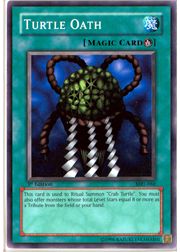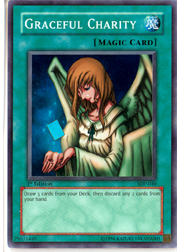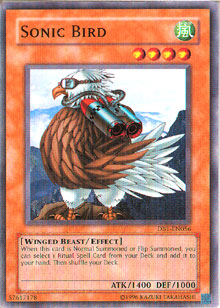I’ll freely admit that a lot of the decks I deal with in this column excite me. I love playing new decks that can win in whatever the current format is, beating out the most popular mainstream strategy. Sometimes my articles are based only on my own deck-building experience, but a great deal of the time, I’m testing the heck out of whatever it is someone sent me because a) I want to do it justice with my suggestions and b) I am really thrilled with its potential. This deck is definitely one of the latter.
It’s made by Jeff Vertrees, who you might remember from Shonen Jump Championship San Francisco last December. At that event, Vertrees played a cool Chaos build that employed Helping Robo For Combat in order to cycle through his deck and get the most out of Thunder Dragon. Apparently he e-mailed me about it, but I managed to miss it when it hit my inbox. I’m glad fate gave me another chance to discuss it here on Metagame.
So, here’s what Jeff had to say about it! This was actually gleaned from a Private Message exchange, so Jeff’s comments jump right into describing the deck.
 The three Sonic Bird cards get the three Turtle Oath cards (which can be any ritual—I just chose Turtle Oath for fun). Turtle Oath is useless on its own, but the three Chiron the Mage cards then drop the Turtle Oath to destroy a spell or trap.
The three Sonic Bird cards get the three Turtle Oath cards (which can be any ritual—I just chose Turtle Oath for fun). Turtle Oath is useless on its own, but the three Chiron the Mage cards then drop the Turtle Oath to destroy a spell or trap.
Now I have a thing about consistency and deck building in Yu-Gi-Oh! and I am obsessed with running cards in threes and thinning my deck, because players mostly feel there's no advantage to it. I showed this in my Helping Robo deck. The three Toon Table of Contents cards can be played one after each other, leaving the final one in your hand—it thins the deck and since that’s two spell cards gone, along with Sonic Bird constantly searching for spells, I can take that high monster count in today’s metagame and decrease my chances of starting with an all-monster hand.
I think this deck shows how the game was meant to be played and I wanted to share it with everyone since I can’t make it to an event this format. It went 6-2 at a Regional in San Jose—its only losses were to time.
Thanks a lot,
—Jeff Vertrees
Sound cool? Here’s the deck list:
T-Rex on Roller Skates—40 Cards
Monsters: 17
3 Sonic Bird
3 Chiron the Mage
3 Marauding Captain
3 Sacred Crane
2 Spirit Reaper
1 Sangan
1 Breaker the Magical Warrior
1 Morphing Jar
Spells: 15
3 Turtle Oath
3 Toon Table of Contents
1 Book of Moon
1 Graceful Charity
1 Scapegoat
1 Premature Burial
1 Snatch Steal
2 Nobleman of Crossout
2 Smashing Ground
Traps: 8
3 Icarus Attack
2 Sakuretsu Armor
1 Mirror Force
1 Torrential Tribute
1 Call of the Haunted
The deck’s really pretty brilliant. I’ve toyed with the idea of how a higher card count can create more even draws when you’re dealing with cards that thin themselves from the deck, but I’d only experimented with monsters. Players of the “Tower of Power” decks can run anywhere from 50 to 60 or more cards and gain some advantage from doing so, knowing that they’ll never draw two Thunder Dragon or two Hero Kid cards in their opening hand. What I’d never considered was what spell-based thinning could mean for a deck’s monster balance. Here, Vertrees has used it to effectively run a disproportionate number of monsters in a deck featuring a very reasonable 40 cards. 17 monsters might not seem like many, until you realize that by turn 2, this deck will often have seen four, five, or even six more cards than its competition.
 Basically, instead of drawing dead monsters early on, this deck draws spells. Those spells then either allow deck thinning (like Toon Table of Contents) or sit in the hand dead. The difference between a dead spell and a dead monster though, is that a spell can still be set as a bluff, draw out removal, or be pitched to Chiron. Smart stuff. Not only does that mean more balance in opening hands, but the deck’s thinning will also ensure that you see power cards like Snatch Steal and Graceful Charity more consistently than your opponent. That’s pretty significant in a format where either of those cards can instantly turn losing games into winning ones.
Basically, instead of drawing dead monsters early on, this deck draws spells. Those spells then either allow deck thinning (like Toon Table of Contents) or sit in the hand dead. The difference between a dead spell and a dead monster though, is that a spell can still be set as a bluff, draw out removal, or be pitched to Chiron. Smart stuff. Not only does that mean more balance in opening hands, but the deck’s thinning will also ensure that you see power cards like Snatch Steal and Graceful Charity more consistently than your opponent. That’s pretty significant in a format where either of those cards can instantly turn losing games into winning ones.
The long-term effects of deck thinning are actually going to be a focus for my work here today. I consider this article to be more of a tweak than a fix, since the deck Jeff presented was completely playable in the form he submitted it, but I think we can take the innovative themes and strategies he was working with and bring them up a notch to create an even better deck. Also, I noticed that Jeff mentioned his only losses in his latest Regional were due to time. If I can make this deck a bit faster and more proactive when it comes to dealing with Spirit Reaper, I think I’ll bring something extra to a build that’s already respectable.
With that said, the first card I want to turf is Morphing Jar. While I could see this as a great side deck pick for a particularly aggressive matchup (one where we’d need more time to draw into Chiron and his support), I don’t think it’s worthy of a main deck spot. This deck can beat just about anything when it comes to card management, and hitting the big ol’ Morphing Jar reset button seems unappealing. For combo-heavy opponents, it’s worth rotating in, but I don’t feel that it’s main deck material compared to other possibilities.
Second up on the chopping block is that pair of Sakuretsu Armor cards. Sakuretsu seems like a dead draw when you’ve got the opponent on the ropes, and considering the amount of control that Chiron can generate, it doesn’t seem worthwhile. Sure, the deck needs to be able to deal with big monsters like Cyber Dragon, but we’ve got other, better ways of doing that. Decree is huge in the North American metagame, and Sakuretsu can’t be pitched to Chiron. There are better tricks available, namely Rush Recklessly. Rush does a lot of what Sakuretsu Armor did, usually blocking everything except for direct shots to your life points. In this deck it presents offensive power as well, letting your Chiron cards attack over Monarchs and allowing you to oust Cyber Dragon cards with Sacred Crane. Rush gets rid of a defense position Spirit Reaper in the battle phase, can be used for extra damage to end a game faster, and can be tossed to Chiron in a pinch to clear the opponent’s back row. There are so many good reasons to use it here that it’s a definite keeper in my mind.
We’ve got one card slot left before I hit the 40 card mark, and though Rush Recklessly will help Jeff with his speed issues, I’ve got other things in mind too. Enraged Battle Ox is going to turn Chiron, Sonic Bird, and Sacred Crane into damage-pressing pierce machines and it’ll give defensive players serious reason to panic against this deck. The ability to pile a board of three piercing monsters into a Spirit Reaper for game is just deadly. So many duelists start setting monsters when they control fewer cards than their opponent, and Enraged Battle Ox punishes them for their cowardly ways. Set a Magician of Faith to try and regain card presence? Here, have some damage. Digging for answers with Magical Merchant? Prepare to wince while Sacred Crane thugs him out with a sack full of doorknobs.
Now we’re at 40 cards, and I could stop the fix right here. But I’m not going to. Instead, I’m going to add a Pot of Avarice suite to the deck, consisting of one Pot and three Nimble Momonga cards. I’m doing this for a few reasons.
First up, being over 40 cards is going to help lower the chance of seeing two Toon Table cards or one or more Turtle Oath cards in my opening hand. The Pot itself is going to allow me to recycle Captains and Cranes for reuse if they get knocked off the table, and free me up to be a bit more aggressive with Captains in the early game. Plus, if I draw Pot of Avarice before I can use it, this deck has an immediate out in the form of Chiron. Just toss the Pot to him, and watch him hurl it at the opponent’s back row. No muss and no fuss, since this deck converts unfortunate spell topdecks into raw removal.
 The Momonga cards bring a lot to the deck. It doesn’t open very well in its original form; there’s virtually nothing that makes a good turn 1 play, aside from perhaps Sonic Bird with a set Icarus Attack if the opponent brings out Cyber Dragon and another monster (and dang, that’s risky). The Momonga cards will keep you around in aggressive matchups, give you extra attackers against a defensive opponent who tries to avoid committing to the field, and even thin themselves from the deck. This thing can go so through so many cards by turn 2 that you don’t see any negative impact from running 44 cards total. Just be aggressive with the Momongas; you’ll often want to kamikaze one just to pull two more and control your deck’s contents.
The Momonga cards bring a lot to the deck. It doesn’t open very well in its original form; there’s virtually nothing that makes a good turn 1 play, aside from perhaps Sonic Bird with a set Icarus Attack if the opponent brings out Cyber Dragon and another monster (and dang, that’s risky). The Momonga cards will keep you around in aggressive matchups, give you extra attackers against a defensive opponent who tries to avoid committing to the field, and even thin themselves from the deck. This thing can go so through so many cards by turn 2 that you don’t see any negative impact from running 44 cards total. Just be aggressive with the Momongas; you’ll often want to kamikaze one just to pull two more and control your deck’s contents.
So the final changes look like this:
-1 Morphing Jar
-2 Sakuretsu Armor
+1 Enraged Battle Ox
+2 Rush Recklessly
+3 Nimble Momonga
+1 Pot of Avarice
The fixed build of the deck is as follows:
T-Rex on Roller Skates—Jason’s Fix—44 Cards
Monsters: 20
3 Sonic Bird
3 Chiron the Mage
3 Marauding Captain
3 Sacred Crane
2 Spirit Reaper
1 Sangan
1 Breaker the Magical Warrior
1 Enraged Battle Ox
3 Nimble Momonga
Spells: 18
3 Turtle Oath
3 Toon Table of Contents
1 Book of Moon
1 Graceful Charity
1 Scapegoat
1 Premature Burial
1 Snatch Steal
2 Nobleman of Crossout
2 Smashing Ground
2 Rush Recklessly
1 Pot of Avarice
Traps: 6
3 Icarus Attack
1 Mirror Force
1 Torrential Tribute
1 Call of the Haunted
This deck is a great combination of groundbreaking core theory and real-world results. Plus, it’s just incredibly entertaining to play. You won’t believe the look on your opponent’s face when you summon Sonic Bird and search your deck for Turtle Oath on turn 1. Try to look like you’ve never played this game before and make remarks like, “I don’t know what a Yugi is.” Hi-larious.
Your ideal defensive openings are to set Nimble, bring out Sangan, or summon Sonic Bird with some sort of protection in the back row. Remember that Marauding Captain is more than just a combo with Sacred Crane. Bring it out with Enraged Battle Ox against a vulnerable field to create big damage. Tag him along with Chiron the Mage and watch your 1800 damage become 3000. Yes, Marauding Captain’s effect means an over-extension in an immediate sense, but in the long term, this deck can easily afford it.
Be careful with how you use Scapegoat. You really do not want to be locked by four Sheep tokens, and since this deck doesn’t use Enemy Controller or Creature Swap, Goat-locking yourself is a definite risk. Being trapped behind a wall of Sheep alienates you from your Captain combos, and if the deck can’t get out multiple monsters, it can’t win. Though this is a control deck, it’s an aggressive one. Don’t get yourself into a situation where you have to use Icarus Attack to eliminate your own Sheep.
There’s not much more to say. This deck can win in a competitive environment, makes use of core theory elements that many duelists overlook, and it’s really fun. It’s only running four cards that cost more than two bucks, too, so it’s pretty darn accessible. Try it out for yourself and see what this game can really be like!
—Jason Grabher-Meyer